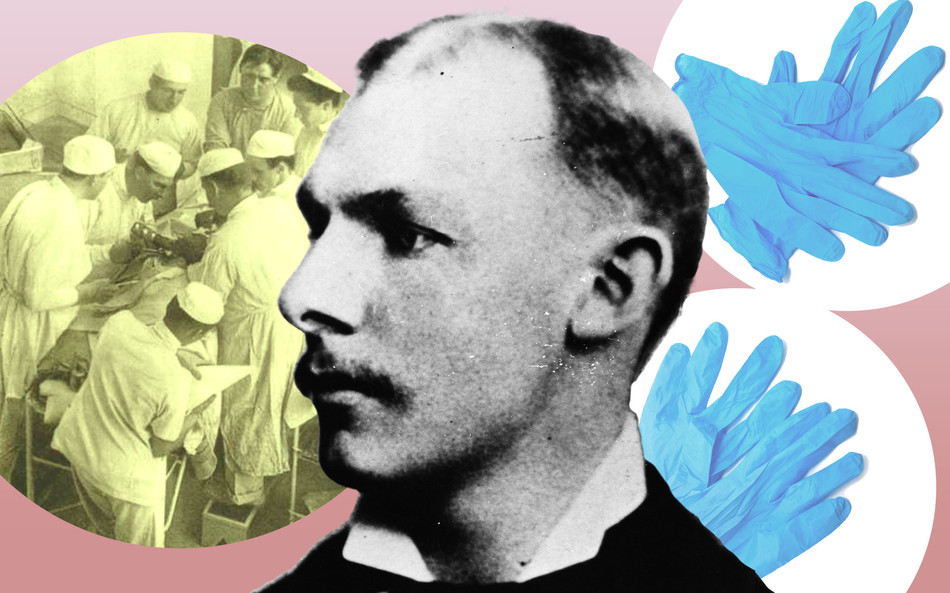Early in his career, William Halsted 1877VPS removed seven gallstones from a patient. The operation, the first of its kind, was performed on a kitchen table, and the patient, a seventy-year-old woman, was Halsted’s mother.
This tableau is a fair indication of Halsted’s unorthodox approach to medicine. Today, a hundred years after his death, this Columbia alum is remembered for a long list of medical advancements, including innovations in hernia surgery, operating-room hygiene, thyroidectomies, vascular aneurysms, wound healing, and, not least, techniques for the gentle handling of tissues and organs in an age that favored surgical speed. Halsted also perfected the radical mastectomy, extending the lives of breast-cancer patients, and was a pioneer in local anesthesia. Away from the table, he developed two medical mainstays: the patient chart and the residency training program for new doctors.
Born in New York to a well-to-do family, the young Halsted was a brilliant surgeon known for his swift scalpel and bold surgical gambits. He was also a handsome bon vivant who loved dinner parties and entertaining. In those New York years, Halsted saved the life of not only his mother but also his sister, who hemorrhaged after childbirth and was near death when Halsted arrived at her bedside. The young surgeon jabbed a syringe into his own arm, extracted blood, and injected it into his sister — one of the first known blood transfusions in America. His sister, like their mother, recovered.
But in 1884, everything changed. Halsted, then thirty-two, had learned of experiments out of Austria in which cocaine hydrochloride was used as a local anesthetic. “Halsted read the papers in a medical journal and realized that the doctors weren’t injecting the right areas to block the nerves,” says Gerald Imber, author of Genius on the Edge: The Bizarre Double Life of Dr. William Stewart Halsted. “So he began doing what a doctor does: he experimented on himself. Then he started using the drug on his students and colleagues at Columbia. Many became addicted; some died from overdose.”
Halsted’s career disintegrated. Seeking treatment for cocaine addiction, he was given morphine — and got hooked on that, too. “But he knew how to manage it,” says Imber. “Using the morphine, he was able to function without the cocaine during the six to eight months he worked. The rest of the time he was injecting cocaine.”
Ruined in New York, Halsted went to Baltimore, where a friend at Johns Hopkins Hospital brought him into the fold. At Hopkins, Halsted attained greatness, becoming a slower, more methodical surgeon who, while actively concealing his addictions — and earning a reputation as an enigmatic recluse — transformed the entire field.
His best-known advance, however, was accidental. In the winter of 1890, when surgery was still a barehanded, blood-soaked affair, Halsted’s scrub nurse, Caroline Hampton, complained that the handwashing solution irritated her hands and arms. Halsted asked the Goodyear Rubber Company to make a pair of thin gloves for Hampton — which proved so effective that soon his assistants began wearing them during surgery. It was only later that the surgical gloves were found to protect patients from infection — so obvious in retrospect that Halsted expressed astonishment that “we could have been so blind as not to have perceived the necessity for wearing them invariably at the operating-table.”
Halsted married Hampton, though the two lived largely separate lives, and he spent more than thirty years as chief surgeon at Hopkins. Like his mother, he suffered from gallbladder disease, and in September 1922, just shy of his seventieth birthday, he became jaundiced. He was taken to Hopkins, where doctors removed several gallstones. When Halsted began bleeding internally, his residents tried to do for him what Halsted had done for his sister: transfusing their own blood into his veins. But they were unsuccessful. Halsted died on September 7.
William Halsted had no biological children, but in another sense, he had many. “Virtually all professors of surgery through the end of the twentieth century in America could trace their academic lineage to Halsted,” Imber says. “He is, without any question, the father of modern American surgery.”
This article appears in the Fall 2022 print edition of Columbia Magazine with the title "The Strange Case of Dr. Halsted."



